It’s the most wonderful time of the year. The carols ring in our ears as we push our carts through endless aisles in search of jaw-droppin’ gifts. We envision this ultimate present, one that causes sweeties to gush and relatives to praise as they unwrap with glee.
Giving books usually doesn’t generate these emotions. The receiver holds the obvious gift, no matter how wonderfully wrapped, as if receiving new underwear or socks. I’ve seen the look, especially from children, which makes me cringe.
Well, not anymore. I have found the perfect little book for infants up to age four. His name is Sheldon, and he is a soft book in the shape of an adorable  sheep. His wool is luxuriously fluffy, plus his purple face beams with a pink-stitched nose and smile. As you unlock the velcro, he falls open to expose two material pages for a six-page rhyming story.
sheep. His wool is luxuriously fluffy, plus his purple face beams with a pink-stitched nose and smile. As you unlock the velcro, he falls open to expose two material pages for a six-page rhyming story.
I envision Sheldon, or Shelly, becoming the teddy bear of future generations. He is the perfect means to instill a love of books and reading. If my name were Mrs. Jessica Mary Claus, I would gladly give one for each child born in the U.S. No need for a security blanket, just hand them Shelly.
Unfortunately, Shelly isn’t available at Wal-Mart or Target, yet. The only source I found was through Bas Bleu Catalog. If you are interested, you may purchase the Sheldon Sheep Soft Book at http://www.basbleu.com/ for $21.95 plus shipping.
Another way to instill a love of reading in children is the easy act of reading to them. I once had a patron who read to her unborn daughter while still in the womb. She would visit the library on her lunch break and read the picture books and nursery rhymes to her belly. Her eight-year-old daughter loves books and wants to become a teacher. Not bad.
Now, if my name were Mr. Santa Claus, I would give each new parent in 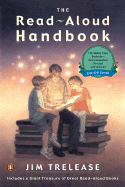 the U.S. a copy of The Read-Aloud Handbook by Jim Trelease. I can hear the parent stammering, “Um, thank you,” not realizing they just received gold.
the U.S. a copy of The Read-Aloud Handbook by Jim Trelease. I can hear the parent stammering, “Um, thank you,” not realizing they just received gold.
Author Trelease’s sixth edition packs a wallop. The book’s seven chapters contain ideas to encourage reading from infancy to young adult. He explains the techniques of reading aloud, including sad male reading statistics, and why it is so important to read. Over 100 pages are dedicated to book titles, which sex they appeal to, and their themes. A gift equal to a lump of gold, not coal.
My Mission...Not Impossible...Make Mississippi Read!
Wednesday, November 29, 2006
Sheldon Sheep Soft Book (copy)
Tags: Booktalk
Sunday, November 26, 2006
All Over but the Shoutin' (notes)
I couldn’t hammer a nail without bending it or severely damaging myself or someone standing near, and if you had depended on me to feed the fire or the hog we would have froze to death, huddled with our emaciated pig. I was a dreamer, and while I loved the woods and the creeks and the natural bounty of our world, I also loved to bury myself in books. After all the lights were shut out, I would cover my head, click on the flashlight, and read as long as the batteries lasted from You Were There books about the Alamo, the Creek Indian Wars, the Battle of New Orleans. I solved mysteries with the Hardy Boys, and drifted down the Mississippi with Mark Twain. By the time I was in the eighth grade, I had read every book—except the ones for the little kids—in the tiny library at Roy Webb Junior High School. I am not bragging. I was just hungry. When I was out of books, I just found a quiet place to dream. p91
Tags: Quote
Saturday, November 25, 2006
Lunch with Books 11/21
This past Tuesday, 11/21, I gave my first club presentation. Yippee! I truly enjoyed the experience and I hope the Senatobia Book Club liked it. The presentation took 35 minutes and was open enough for questions between bullets. There were ten fun book talks within the speech.
The talk was developed specifically for Senatobia’s book club, but it might be valuable for other librarians or book club leaders. The previous blog is my presentation notes for anyone to use in the spirit of, "Steal this Idea." Hope y'all can use it!
Sorry, I don’t have anything for handling the dominating talkers or off-topic discussers. Although, I know these are universal problems, and we could use some tips. Right, Booklogged?
10 Ideas to Revitalize a Successful Book Club
1. Book clubs are meant to be…enjoyable social occasion; conversation with people who like to read
¶ Why not have all the members bring a book they have enjoyed past or present to book talk. (explain book talk)
2. Book clubs develop…according to the personality of its members. (serious vs. hoped for)
¶ Why not read something different by the same author one month. (explain author study) serious bio/hoped for short stories.
3. Book clubs that meet…in the library attract a variety of members with a variety of taste. (library vs. home clubs)
¶ Why not chose a book in which all readers will have something in common…Mississippi (Smile Please and/or One Mississippi)
4. Book clubs cannot survive on books alone…Food is very important! The act of breaking bread provides social interaction before the discussion. (sweets enhance insight)
¶ Why not read a book of fiction containing recipes and then have members bring in some of the dishes. (Being Dead is No Excuse or Jan Karon)
5. Book clubs are great…for sharing outside the initial discussion. (take home discussion)
¶ Why not try a mother-daughter, grandmother-granddaughter, or husband-wife meeting when both read a book and share w/ club. (A Northern Light)
6. Book clubs sometimes… need suggestions for the next best read. (Laurie/Margaret/internet/NoveList)
¶ Why not meet one month at the local bookstore and stroll the lit. aisles pulling your favorites. Cull books and discover tastes…
7. Book clubs sometimes…need visual stimulation. (who will play?)
¶ Why not read a book then attend a showing of the movie at the cinema or local library. (Running with Scissors or The Egg and I)
8. Book clubs have members…who have only experienced one culture, the South. (others may travel)
¶ Why not read a book representative of another culture or country. One can explore differences and humanity. (Things Fall Apart and/or Snow Flower and the Secret Fan)
9. Book clubs may… look for inspiration from outside the immediate community.
¶ Why not let a local author entertain the group with his latest offering. (Memphis Crump Don't Like It and /or Waltzing at the Piggly Wiggly)
10. Book clubs give…the participants a license to read something they would never consider.
¶ Why not try a theme approach w/ a kooky but interesting subject. (The Lobster Chronicles and/or The Secret Life of Lobsters)
Wednesday, November 22, 2006
I am the Turkey (review)
 Michele Sobel Spirn. I am the Turkey. Illus. Joy Allen. New York: HarperCollins, 2004. 48pp. Grades 1st-3rd.
Michele Sobel Spirn. I am the Turkey. Illus. Joy Allen. New York: HarperCollins, 2004. 48pp. Grades 1st-3rd.
You will have the beginnings of a realistic fiction reader after they tackle this, “I Can Read!” book from HarperCollins. The Thanksgiving play is coming closer and Mark has been chosen for the part of the Turkey. All is sunshine and roses until Mark overhears his big brother call him the class turkey. Later, on the way home from school, big brother gives Mark the low-down, “The Pilgrims and the Indians eat you.” Mark suddenly has more to worry about than his lines, “Gobble! Gobble! Gobble!” He will have to try his darnedest not to be a dead duck or turkey in this case. Many new readers will relate to this book on different levels, having to participate in their first class play, being assigned parts that aren’t as cool as first thought, and the ever present older sibling that loves a good tease. Sit back and enjoy the pre-reading child sound out the word “thanksgiving” for the first time and without help. An accomplishment the child will wish to produce by returning to the book even after the holidays.
Tags: review
Someone Bigger (review)
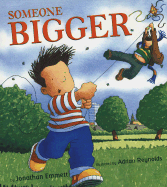 Jonathan Emmett. Someone Bigger. Illus. Adrian Reynolds. New York: Clarion Books, 2003. 32pp. Grades PreK-3rd.
Jonathan Emmett. Someone Bigger. Illus. Adrian Reynolds. New York: Clarion Books, 2003. 32pp. Grades PreK-3rd.
Just like the little Dutch boy that stuck his finger in the dyke and held back a river, so too does this book remind us sometimes bigger isn’t always better. Sam is off to the park to fly his homemade kite with Dad. From the beginning we fall hypnotically into the lyrical prose as it looks like Dad wants to do all the work and have all the fun. Dad’s enjoyment is kept in motion by hushing his son with, “This kite needs someone bigger.” As the blustery illustrations show Dad being swept away, others grab hold of the string and try to pull it down. In seconds there is a long line of helpful citizens and eager zoo animals that try to add their weight. Children will delight in the Macy’s Day Parade style illustrations that add a floating procession of bulbous looking characters holding onto the kite string. As Sam saves the day your amused listeners may be able to recite those involved in descending order. A soon to be storytime favorite with all ages memorizing, “Can I hold it now?’ asked Sam, “I’m old enough- I know I am!”
Tags: review
The Giant and the Beanstalk (review)
 Diane Stanley. The Giant and the Beanstalk. New York: HarperCollins, 2004. 32pp. Grades PreK-2nd.
Diane Stanley. The Giant and the Beanstalk. New York: HarperCollins, 2004. 32pp. Grades PreK-2nd.
Otto, the Giant, wants his hen back, but he cannot find the right Jack in this tale of mixed-up folktales. Otto isn’t like the other giants in the magical kingdom. For one thing he is too nice and caring. When he could pick any ferocious pet in the kingdom’s pet store he chooses a hen instead. His confused and upset parents allow him to keep it because it lays golden eggs. One morning Otto surprises a human pilfering around his kingly home. When the human gets one look at him he grabs the hen and heads for a new beanstalk in the kingdom fields. In hot pursuit Otto climbs down after him and begins his search for the hen in the human kingdom. Otto starts to feel like he is on a wild goose um hen chase as he goes from Jack to Jack and still hasn’t met the correct one. Will Otto turn into a gruesome fierce Giant after spending time with humans in the search for his beloved pet hen? Author Staley has created another amusing story that children will be sure to love. Children will engage their brains trying to figure out the next Jack from common nursery rhymes as their eyes fill with beautiful illustrations.
Tags: review
Good Night, Copycub (review)
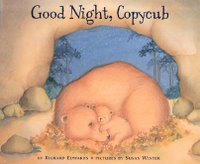 Richard Edwards. Good Night, Copycub. Illus. Susan Winter. New York: HarperCollins, 2004. 32pp. Grades PreK-1st.
Richard Edwards. Good Night, Copycub. Illus. Susan Winter. New York: HarperCollins, 2004. 32pp. Grades PreK-1st.
An important step in any child’s development is being able to accomplish things on their own. One way to learn things for oneself is to mimic the actions of others. Copycub is having trouble sleeping and has inadvertently awakened Momma bear with his tossing. This loving mother takes him on a midnight amble through the forest of sleeping inhabitants. Copycub encounters a goose, a moose and a hare dozing, “Safe and sound.” When he returns to the cave his mother encourages him to copy the animals. The illustrations set a sleepy mood with a full moon and long shadows of a clear blue sky. Momma is given a drowsy feel with her eyes held at half-mast and the honey color of the animals radiates warmth. This is the perfect bedtime book; for even the repetitive prose has a couple of yawns included, for extra slumber time encouragement. What a clever book to provide a child with the means to fall asleep on their own.
Tags: review
Crepes by Suzette (review)
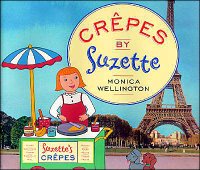 Tony Monica Wellington. Crepes by Suzette. New York: Dutton Books, 2004. Unpaged, Grades PreK-2nd.
Tony Monica Wellington. Crepes by Suzette. New York: Dutton Books, 2004. Unpaged, Grades PreK-2nd.
Magnifique! Who wants crepes? Mais Oui! This book takes you on an extraordinary tour of Paris combining art with the sights. As you travel along with Suzette, actual photographs of the city appear in the background. The street pulses with pedestrians and autos on their way to work. The market place hums exotically with a cosmopolitan air as families dicker with peddlers. The park invites one to stop and smell the roses or just people watch. It isn’t until the Luxembourg Gardens scene when one realizes Suzette is serving to famous art paintings. I’m embarrassed to say I passed right by the Postmaster of Arles assuming it was part of Suzette’s illustrated family and not a representation of Van Gogh’s work. This book provides a great chance to explore art from famous artists by introducing the original works that inspired the cartoon versions. A child will delight in the French phrases although you will need to know them prior to reading aloud for they are not pronounced in the text. Notes in the back of the book include a recipe for crepes, glossary of French words, notes on the photographs and paintings. Author Wellington will sate any young child’s appetite for art and architecture along with encouraging their ability to find the same photographed children amongst the crowds.
Tags: review
Let's Eat (review)
 Beatrice Hollyer. Let’s Eat: What Children Eat Around the World. New York: Henry Holt, 2003. 41pp. Grades 3rd-5th.
Beatrice Hollyer. Let’s Eat: What Children Eat Around the World. New York: Henry Holt, 2003. 41pp. Grades 3rd-5th.
Open this book and explore the eating habits of five different children in five different countries. In South Africa, you will gather firewood and weed the garden with Thembe then join the family for a traditional wedding. In Mexico, you will follow Luis as he tries to lasso a ewe and travel to the big city for Fiesta. Thailand comes alive as AA takes us to the market in the morning and we watch her poach quail eggs. With Jordan we truffle hunt and make chocolate cake without a recipe in France. The final country is India where we follow Yamini to school and the market then celebrate her birthday. The author provides a recipe per country and food glossary for the more exotic items. Unfortunately a pronunciation guide is not provided. This colorful picture book is perfect for geography studies. Just think of the fun you will have trying to make these delicious treats with little cooks.
Tags: review
Buried Fire (review)
 Jonathan Stroud. Buried Fire. New York: Hyperion Books, 2004. 332pp. Grades 6th-Up.
Jonathan Stroud. Buried Fire. New York: Hyperion Books, 2004. 332pp. Grades 6th-Up.
Are you ready to lose yourself in a book that will have you reading all day long? This book, by the author of The Amulet of Samarkand, is ready to please. From the very first sentence we are entranced. “Under the old king’s barrow, in a hollow place hidden from the winter mists and the summer sun, a dragon coils.” Directly above this hallowed spot Michael is presently napping. While he naps the local Vicar is directing workers digging outside St. Wyndham church to stabilize its foundation. As workers strike a hard surface, the dragon stirs and a small bubble begins to rise from his lair. This bubble incases Michael on its exit from the hill and bestows magical powers to him as he slumbers. Meanwhile the workers uncover an ancient Celtic like cross from the trench below the church. Are you hooked yet? This fast-paced plot keeps moving by mini cliffhangers at the end of chapters and perilous large ones at the end of days. All the events take four days to occur. A stripped down version was read for this review. One can only hope the final copy will include illustrations and a map of the Wirrim area.
Tags: review
A Couple of April Fools (review)
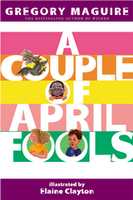 Gregory Maguire. A Couple of April Fools. Illus. Elaine Clayton. New York: Clarion Books, 2004. 182pp. Grades 6th-Up.
Gregory Maguire. A Couple of April Fools. Illus. Elaine Clayton. New York: Clarion Books, 2004. 182pp. Grades 6th-Up.
What do you get when you genetically cross a domestic chicken with a Galapagos blue-toe lizard? It isn’t as pretty as it sounds. In this sixth book in Maguire’s count-down series we are again facing the unknown as three eggs hatch and these blue-green thingies emerge. Creatures the locals call “Flameburpers” for they shoot out little puffs of flames. Dangerous conditions considering chickens are normally found around barns full of hay. Rival clubs of children, the Tattletales and the Copycats, find them adorable and have become quite attached. Unfortunately one has run into the woods and another has met an untimely death. The children visit the remaining one after school each day, this one is getting larger, scalier and moodier despite the tender stepchicken raising her at Fingerpie Farms. Between visits the rival clubs have been planning April Fools day tricks. These tricks have the power to prove which faction is smarter, the Tattletale girls or the Copycat boys. I’m rooting for the girls in this fun read-aloud. Would be perfect to read all of Maguire’s series out loud as you travel through the same fourth or fifth grade class in a year.
Tags: review
Earthshake (review)
 Lisa Westberg Peters. Earthshake: Poems from the Ground Up. Illus. Cathie Felstead. New York: Greenwillow, 2003. 32pp. Grades 4th-8th.
Lisa Westberg Peters. Earthshake: Poems from the Ground Up. Illus. Cathie Felstead. New York: Greenwillow, 2003. 32pp. Grades 4th-8th.
This poetry book could be the next School House Rock for eager young geologist. Although the format looks easy; these poems are for sophisticated young readers possessing more developed minds. Once the correct audience gets a hold of these poetic earth gems they will have a better understanding and enjoyable way to remember difficult physical concepts. For example, the continental plates sit on the continental shelves of earth’s dishwasher and Peters ask the reader to just let the forks in the river soak. Old faithful becomes a land locked underground whale that shoots water through his blow hole and flicks his tail causing mild tremors. The poems also encourage kids to look around and find geodes by the side of the road or fossilized clams in their sidewalk. The illustrations are mesmerizing in blues, greens, and oranges; plus the cut out maps suggest a day of outdoor exploring. Teachers can use these short surprising poems to begin all types of classroom discussions as students hear about China’s clay hills, Washington State’s sea cliffs and Michigan’s sand dunes. Let Earthshake flow like lava and be prepared for the river of ideas it exposes.
Tags: review
The Truth About Poop (review)
Susan E. Goodman. The Truth About Poop. Illus. Elwood H. Smith. New York: Viking Books, 2004. 40pp. Grades 3rd-6th. 
Don’t shy away from this information packed book just because of the title. In our current world of reluctant readers we need all the enticing books for boys we can find. I see young boys between the ages of eight and ten clamoring for this book in hopes of finding their next bathroom joke. Once they delve inside this book their heads will be absorbing all kinds of poop trivia known to present day man. Michelangelo bathed his statues in donkey poop to give them an aged patina. Many cultures have rubbed poop on their face to get rid of freckles. The first public bathrooms in European cities were outhouses located on bridges. The book contains cleverly organized chapters featuring animal droppings, the elimination process, and the uses for poop. An afterword contains further readings for adults and children plus a website called theplumber.com. (Puts a new spin on seeing "the plummer" in Bloglines!) The illustrations enhance the fun. They contain poop that sometimes looks more like chocolate chip cookies than cow patties. Again, you needn’t be afraid of owning this book. You may just inspire the world’s next Nobel scientist who transforms poop into a clean source of alternative fuel.
Tags: review
Thursday, November 16, 2006
An Ordinary Man (notes)
There is no greater gift to an insecure leader that quite matches a vague "enemy" who can be used to whip up fear and hatred among the population. It is a cheap way to consolidate one’s hold on power. p27Many of us have encountered this despicable human behavior as early as elementary school. Two girls, without anything in common, can strike up a friendship by making fun of someone else. It becomes their shared secret from whence other conversations grow. It can also become a friendship breaker. For example, one in the bond actually talks to the outsider, thus becoming disloyal to the original pair.
A psychologist would agree both these girls are insecure. Without knowing, they use this mean tactic, to ease their uncertain position. I heard it expressed by this phrase, “Nothing bonds friendship like a common enemy.”
Any excuse will serve a tyrant. p96
It doesn’t have to be a sane, rational excuse. If you want someone gone, just catch that person breathing wrong. A trick I learned from a past insecure boss.
Wednesday, November 15, 2006
An Ordinary Man (copy)

In the mid 1800’s, a British explorer’s theory evolved into the 1994 genocide in Rwanda, Africa. The first white man to see Lake Victoria, John Hanning Speke, claimed the two tribes in the Rwanda region were direct descendants from the Bible.
Speke theorized the Tutsis were a lost Christian tribe from the Middle East. The Tutsis were a thin-nosed, tall race, who ate beef and drank milk. They immediately escaladed from poor tribe to royal subjects with this new knowledge.
Their counterparts, the Hutus, were direct descendants of Noah’s son, Ham. As the Genesis story goes, Ham is forced into servitude for his sins against Noah. The Hutus, described as farmers, short and stocky in stature with wide noses, became overnight un-successes. They went from independent providers to dumb animals in need of a master.
In reality, one could not tell a difference in the races, because one didn’t exist. Speke saw an opportunity to pontificate his claims and consequently weighed one group against the other. A person today would merely assume the cattle-owning Tutsis benefited from better nutrition.
As the years progressed, the Tutsis became tyrant leaders. They believed themselves special and entitled to more of Rwanda’s resources. Since they owned the cows, they needed more land to support them. The Tutsis spread their claim; and an economic divide, as well as social, began to form.
On April 6, 1994, a huge explosion rocked the capital city of Kigali, Rwanda. Tatiana called her husband in fear, begging him to return to their home. Her husband, Paul, was manager of the premier Rwandan Hotel Diplomate. Paul was also a Tutsi and his wife Tatiana a Hutu.
As he rushed home he noticed civilians, even his neighbors and their children, sporting uniforms and machetes. The car radio exclaimed, “Do your work. Clean your neighborhood of brush. Cut all the tall trees.”
An Ordinary Man is the autobiography of Paul Rusesabagina and his experience in the 100-day revolt. A horrendous 850,000 Rwandans lost their lives. Paul, living in the very hotel used as Hutu headquarters, kept 1,268 Tutsis in the hotel alive through verbal reasoning. This incredible story is the basis for the 2004 movie, Hotel Rwanda.
Tags: Booktalk
Monday, November 13, 2006
Children's Book Week!
Friday, November 10, 2006
Good News!
 My article for Veteran's Day books will appear in the North Mississippi Herald in Water Valley. This is the first time for me to appear in their weekly newspaper.
My article for Veteran's Day books will appear in the North Mississippi Herald in Water Valley. This is the first time for me to appear in their weekly newspaper.
I am also a weekly column in the new start up paper, The Southaven Press out of Olive Branch. They are so new, they don't have a website yet.
So, if you are keeping count, I appear regularly in The Southern Reporter, The Tate Co. Democrat, The DeSoto Tribune, and The Southaven Press. I am filler for The Sun-Sentinel and The Tunica Times. We will just have to wait and see if North MS Herald runs a weekly Booktalk. Yippee!
Wednesday, November 08, 2006
Dying to Win & The Crisis of Islam (copy)
As Veterans’ Day nears, one’s reading list of books could represent other military holidays such as Memorial, Flag and Armed Forces Day. A popular and readable list might include: James Bradley’s Flags of Our Fathers or Flyboys, Stephen E. Ambrose’s Band of Brothers or Citizen Soldiers, and even Tom Brokaw’s The Greatest Generation.
Although these create a great list, they really don’t reflect the true picture of today’s veterans. Today’s veterans can be as young as 18 years old. This younger troop may have served in Iraq last month; older veterans may have seen conflicts in Korea, Vietnam, and the Middle East.
The battlefields of these young veterans may be the same sand, grass and pavement; yet the machinery used to gain this ground is quite technically advanced. The battlefields are now mapped in computer coordinates not dead reckoning. Airplane bombers no longer need fighter pilot escorts, since bombs are dropped from the super stratum. Heck, even the bombs are smarter.
How do we win a War on Terrorism when our enemies are unseen terrorists? I guess naval officers faced this same dilemma in the Pacific theater during World War II. The first Kamikaze must have been seen as a fluke, until five more followed suit.
For this Veterans’ Day, spend some time exploring terrorism and its chilling threat to our current and future servicemen and women. Both, Dying to Win: The Strategic Logic of Suicide Terrorism by Robert Pape and The Crisis of Islam: Holy War and Unholy Terror by Bernard Lewis, bring a historical perspective with future consequences.
Author Pape is a political scientist at the University of Chicago. He claims Dying to Win is, “groundbreaking evidence to explain the strategic, social, and individual factors responsible for [terrorism].” He is also the first author to provide an all-inclusive list of suicide attacks since 1980.
He claims Dying to Win is, “groundbreaking evidence to explain the strategic, social, and individual factors responsible for [terrorism].” He is also the first author to provide an all-inclusive list of suicide attacks since 1980. Author Lewis’s award-winning essay in The New Yorker has been expanded into The Crisis of Islam. The book is a comprehensive, historical journey through 13 centuries of Islamic culture. From the Crusades to modern times, Lewis provides religious and political reasoning for resentment and acts of terrorism towards America.
Author Lewis’s award-winning essay in The New Yorker has been expanded into The Crisis of Islam. The book is a comprehensive, historical journey through 13 centuries of Islamic culture. From the Crusades to modern times, Lewis provides religious and political reasoning for resentment and acts of terrorism towards America.
Whatever you read, remember our veterans November 11; they have served us well.
Tags: Booktalk
Monday, November 06, 2006
Winter Reading Challenge

Just signed up for another reading challenge at Overdue Books blog. I have from November 1st to January 30th to read 5 books in my TBR stack.
My books TBR are:
- Mockingbird by Charles J Shields
- One Mississippi by Mark Childress
- Provence A-Z by Peter Mayle
- Things I didn't know by Robert Hughes
- Thunderstruck by Eric Larson
Sunday, November 05, 2006
A Southerner Ascends North
Saturday, November 04, 2006
A Shared Weakness!
Thursday, November 02, 2006
RIP Challenge Wake!
 I read Everyman by Philip Roth, The Thirteenth Tale by Diane Setterfield, Spook by Mary Roach, Ghost Hunters by Deborah Blum, and upteen million short stories. I tried reading Frankenstein by Mary Shelley, but it wasn't meant to be. Thanks again Carl the Fifth!
I read Everyman by Philip Roth, The Thirteenth Tale by Diane Setterfield, Spook by Mary Roach, Ghost Hunters by Deborah Blum, and upteen million short stories. I tried reading Frankenstein by Mary Shelley, but it wasn't meant to be. Thanks again Carl the Fifth!Wednesday, November 01, 2006
Frankenstein (copy)
 Some books are awe-inspiring; some books are thought provoking; some books are lyrical; and some books are duds. Huh, did I just write dud? What would cause me to say that? I’m normally all about the book. How can I be so negative?
Some books are awe-inspiring; some books are thought provoking; some books are lyrical; and some books are duds. Huh, did I just write dud? What would cause me to say that? I’m normally all about the book. How can I be so negative?
As one can imagine, in order to write a weekly column on books I need to constantly read. I usually start a book on Thursday and finish reading it Saturday. That gives me enough time to read another book if the first is “dudish.” If the second book is also a dud, well, I write to you about dud books.
This is where I stand as of Wednesday morning, 9:30. I had really high hopes for the book Frankenstein by Mary Shelley, but as the days past, this pop cultural icon felt more like a school assignment. I would read a chapter, fall asleep, reread a paragraph, fall asleep, and then reread from the beginning. I think you get my predicament.
I could recommend this book to anyone experiencing trouble falling asleep, but that would be all wrong. This is my situation. Another person may pick up the book and be drawn in for hours. They might even devour it in one sitting. It all depends on the mood one is in when they start a book. I apparently was in a drowsy mood.
This brings up an important question. Do you always finish a book once you start it, even if it drags? I have a feeling most of you are nodding your heads, yes.
My beloved is the same way. He reads a book like he is on a mission. Your mission, if you chose to accept it, is to drag your eyes across every word in this work, even if it may cause loss of time and entertainment in order to succeed. “Yes, sir, and may I have another!”
Not me. I give the book a fifty page limit. If I’m not hooked by the fifty-first page, it goes back to the library. It just doesn’t seem proper to waste time on something you aren’t enjoying. There aren’t any teachers looking over your shoulders telling you it has to be read. Sort of takes all the fun out of reading, if you think of it in this manner.
Mood is everything when it comes to reading. If you aren’t in a certain mood for a certain book, you really are wasting time. The bright side to this mood is it may change. A dud at this time and place may become a gem years later.
So, I give you my permission not to read a book, if by fifty pages it evolves into a dud. The problem with Frankenstein—I never got to page fifty. I found myself snoring by page twenty.
Cartoon by Chris Burke
Tags: Booktalk
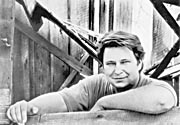


 ~
~ 

